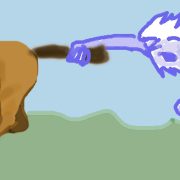The Patron Saint of potters
It must have been hard for Lady Eleanor Butler and Miss Sarah Ponsonby living in Plas Newydd, a stone built house converted into a gothic ‘fantasy’, since all they wanted was to be left alone after running away from their families and setting up home in Wales in 1778. They lived there for 50 years but became such objects of curiosity that they often had to politely receive visitors.
“Who is it at the door this time, Sarah?”
“Oh, it’s the Duke of Wellington again. Shall I show him in?”
And so on and so forth: Wordsworth, Shelley, Sir Walter Scott, Josiah Wedgewood, Byron all beat a path to the heavily ornamented Gothic door of their remote “Cottage.”
I, however, was on another mission linked more to the great Josiah Wedgewood than cultural curiosity, because I was delivering some pieces to Gwalia Ceramics in the heart of Llangollen and discovering that ‘The Ladies of Llangollen’ must have been attracted to the area by the beautiful Welsh hills, the fast running River Dee and the woodlands that surround the town.
How to pronounce Llangollen: [LAN] + [GOTH] + [LUHN]. Or click here to hear it pronounced.
The Gwalia Ceramics is a jewel of a gallery run by Jacqui Atkin, herself a very fine ceramicist and potter, as well as editor of Clay Craft magazine. Any visitor would enjoy dropping in – it is a small space but the ceramics are beautifully displayed. Wedgewood would have loved it because even though he is credited with the industrialisation of the manufacture of pottery, it was the beauty of ware such as the Portland vase that spurred him to innovate.
And Llangollen is a place with an easy charm that invites walking about and exploring.
The Ellesmere Canal runs along the Dee here and it is unusual amongst Britain’s artificial waterways in having a strong flow (up to 2 miles per hour). The route, twisting through hills and across the Dee Valley, has made it the most famous and busiest in Britain. The canal is an important part of Llangollen’s attraction as a holiday destination. A marina, built at the end of the navigable section, allows summer visitors to moor overnight in Llangollen. I mention this in case any of you decide to visit by boat.
You can get there by train, changing in Liverpool, and then getting a bus, alighting at the Llangollen Memorial. And for steam enthusiasts, there is the Llangollen steam railway located beside the Dee Bridge. The journey is a relaxing 10 miles travelling through the stunning Dee Valley to the lovely town of Corwen the crossroads of North Wales. This small section of line, which in its day went from Ruabon to Barmouth taking people to the seaside on holiday and transporting various goods including slate and chemicals, follows the River Dee for its entire length, passing through some of the finest natural beauty North Wales has to offer.
The bridge over the Dee is 16th century and gives you a dramatic view of the torrents below (it was a particularly wet and rainy day), and the High Street has enough good coffee shops for a break. I discovered a seriously good pastry shop selling something I have not come across before: Yorkshire Wraps. This is essentially a large circular Yorkshire pudding with raised edges which is then filled with a delicious thick meaty stew – not very Welsh, I agree, but somehow it did not matter, and it means I can slip in the one about the man from Barnsley who goes to the vet. Vet says:
“I hear you’ve got problems with the cat?”
“Aye” the man replies
“Is it a tom?”
“No,” replies the man, “I brought it wi’ me!”
Llangollen was established in the 7th Century when the monk St. Collen was instructed to find a valley by riding a horse for one day and then stop and mark out a “parish” a place to build his hermitage. This got me thinking about saints and I realized I had no idea who the Patron saint of potters is.
Well, it is St Spyridon. He converted a pagan by using a piece of broken pottery to illustrate how one single entity could be composed of three unique entities (fire, water and clay); a metaphor for the Christian doctrine of the Trinity. As soon as Spyridon finished speaking, the shard is said to have miraculously burst into flame, water dripped on the ground, and only dust remained in his hand. So, good man though he undoubtedly is, it is probably best not to lure him into the Gwalia gallery



















